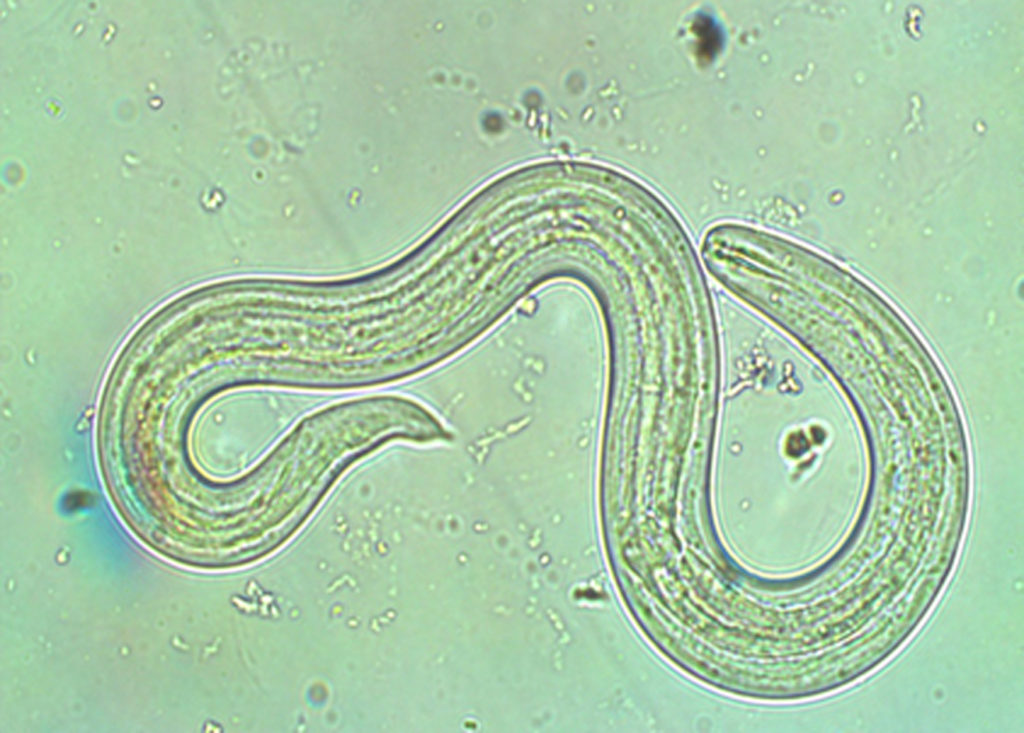Rat Lungworm Confirmed in 3 Big Island Visitors

The rat lungworm parasite under a microscope. Photo courtesy of Dr. Susan Jarvi
The Hawai‘i Department of Health (DOH) has received notification from the Centers for Disease Control and Prevention (CDC) that its laboratory confirmed three unrelated cases of angiostrongyliasis, or rat lungworm disease, in visitors to Hawai‘i Island.
All three individuals are adult residents of the US mainland and were traveling in Hawai‘i when they were infected with the parasite causing rat lungworm disease.
One of the individuals visited East Hawai‘i in December 2018 and became infected by purposely eating a slug on a dare. The individual became ill in late December but was not hospitalized. The adult visitor was the eighth person infected on Hawai‘i Island who tested positive for angiostrongyliasis in 2018, bringing the statewide total to 10 confirmed cases last year.
The other individuals confirmed by the CDC laboratory were traveling on the west side of Hawai‘i Island during their visits. One of these individuals became ill in early January 2019 and was not hospitalized for their symptoms. After an investigation, it is not known how the individual was infected; however, they do remember eating many homemade salads while on vacation.
The other individual became ill in late February 2019 and was hospitalized for a short time. The investigation was not able to identify an exact source of infection, but the individual likely became infected while “grazing”—eating unwashed raw fruits, vegetables and other plants straight from the land.
With the additional cases confirmed by CDC, this brings the statewide total to five confirmed cases of angiostrongyliasis in 2019, all of which were contracted on Hawai‘i Island.
“It’s important that we ensure our visitors know the precautions to take to prevent rat lungworm disease, which can have severe long-term effects,” said Health Director Bruce Anderson. “Getting information to visitors about the disease is just as critical as raising awareness amongst our residents.”
The Department of Health provides information to visitors traveling to Hawai‘i with signage in local airports and shopping centers.
Anderson added, “We recognize that there is more work to be done in educating residents and visitors and making sure they know how to prevent the spread of this disease.”
DOH provides the following recommendations to prevent rat lungworm disease:
- Wash all fruits and vegetables under clean, running water to remove any tiny slugs or snails. Pay close attention to leafy greens.
- Control snail, slug, and rat populations around homes, gardens and farms. Get rid of these vectors safely by clearing debris where they might live, and also using traps and baits. Always wear gloves for safety when working outdoors.
- Inspect, wash and store produce in sealed containers, regardless of whether it came from a local retailer, farmer’s market, or backyard garden.
For more information about rat lungworm disease and how to prevent its spread, visit:
DOH website: http://health.hawaii.gov/docd/disease_listing/rat-lungworm-angiostrongyliasis/
HDOA website: http://hdoa.hawaii.gov/blog/main/rat-lungworm-information/
CTAHR website: http://manoa.hawaii.edu/ctahr/farmfoodsafety/rat-lungworm/
CDC website: https://www.cdc.gov/parasites/angiostrongylus/index.html
Angiostrongyliasis, commonly known as rat lungworm disease, is caused by a parasitic roundworm and can have debilitating effects on an infected person’s brain and spinal cord. In Hawai‘i, most people become ill by accidentally ingesting a snail or slug infected with the parasite Angiostrongylus cantonensis (A. cantonensis). Symptoms vary widely between cases, and the most common ones include severe headaches and neck stiffness. The most serious cases experience neurological problems, severe pain and long-term disability.













